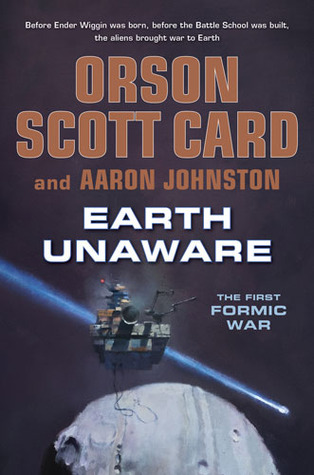In the vast landscape of science fiction, few authors have cultivated as devoted a following as Orson Scott Card.With Earth unaware, the first installment of the First Formic War trilogy, Card invites readers to revisit the harrowing origins of humanity’s earliest encounter with alien invaders. This novel not only expands the universe established in his renowned Ender’s Game series but also carves out its own narrative space, blending tense action with contemplative moments. In this review, we delve into the layers of Earth Unaware, exploring how Card balances familiar themes of survival and ingenuity with fresh perspectives on first contact and conflict, all while setting the stage for an epic interstellar saga.
The Intriguing Premise of Earth Unaware and Its Place Within the Exponential Saga
At the heart of Earth Unaware lies a captivating exploration of humanity’s first encounter with an interstellar threat, setting the stage for the expansive narrative of the Exponential Saga. Unlike conventional sci-fi that fast-forwards into epic battles, this novel meticulously constructs the tension through the lens of ordinary people thrust into unusual circumstances. The story’s premise doesn’t just explore alien invasion but delves into the human condition - perseverance, fear, and ingenuity – in the face of an unknown and seemingly insurmountable enemy.This grounding in relatable human emotions enhances the suspense and emotional investment, making the looming conflict feel immediate and personal.
Positioned as a prequel, the book enriches the overall saga by offering critical backstory and context that illuminates the motivations and technologies seen later in the series. It masterfully balances world-building with character progress, ensuring readers become deeply connected with the unfolding events. Here are key elements that define its unique contribution:
- historical first contact: Detailed depiction of humanity’s initial awareness of extraterrestrial life.
- Technological evolution: Early innovations and adaptations shaped by the imminent threat.
- Political dynamics: insightful portrayal of global responses and alliances formed under pressure.
- Human perspectives: Multidimensional characters representing diverse societal roles and reactions.
| Aspect | Contribution to Exponential Saga |
|---|---|
| Plot Foundation | Establishes main conflict and stakes |
| Character Origins | Introduces key figures in formative roles |
| Technological Context | Explains early sci-fi tech developments |
| Thematic Depth | Explores human resilience and unity |
How orson Scott Card Captures the Tension Between Humanity and Alien Threats with Vivid Storytelling
Orson Scott Card deftly intertwines human vulnerability with the looming menace of extraterrestrial invaders, crafting a narrative that pulses with palpable tension. Rather than relying solely on high-octane conflict, Card delves deep into the psyche of his characters, illuminating their fears, hopes, and resilience against an unknowable enemy. His vivid descriptions anchor otherworldly threats in raw, emotional reality, allowing readers to feel the weight of humanity’s precarious position. It’s this balance-between the intimate and the cosmic-that elevates the story, making every encounter with the alien forces both terrifying and profoundly human.
Card’s storytelling prowess shines through his use of multifaceted perspectives and immersive world-building. He captures the nuances of cultural clashes, moral dilemmas, and survival instincts with sharp precision. Among the tools he employs to amplify this tension are:
- Dynamic character arcs that reveal the evolving human spirit amidst chaos
- Poignant dialog that conveys conflict beyond words
- Evocative settings that juxtapose familiar Earthly landscapes with alien strangeness
| Element | Effect |
|---|---|
| Close POVs | Heightens empathy and immediacy |
| Alien Descriptions | Fosters unease and mystery |
| Human Flaws | Creates relatable tension |
Detailed Character arcs That Ground the Epic Conflict in Relatable Human Experiences
Orson Scott Card masterfully crafts characters whose personal journeys breathe life into the sprawling cosmic conflict. Each protagonist is more than just a cog in the machinery of interstellar warfare; they wrestle with intimate dilemmas-loyalty versus survival, fear versus courage, and the longing for connection amid chaos. This emotional depth transforms the narrative from a mere sci-fi thriller into an exploration of the human spirit confronting the unknown. Readers find themselves rooting for these individuals not solely because of their heroism but because their struggles echo the complexities of real human experiences.
what sets these arcs apart is the nuanced evolution of the characters over time, highlighted through moments of vulnerability and revelation. The story’s structure emphasizes:
- Internal conflict: Characters continuously confront their own fears and desires.
- Relationships: The bonds between family and comrades shape decisions and motivations.
- Growth: Each trial leads to meaningful transformations, reflecting the resilience of the human condition.
| Character | Core Struggle | Key Growth Moment |
|---|---|---|
| Lieutenant Rigo | Duty vs. Compassion | defies orders to save civilians |
| Engineer Yao | Fear of Failure | Innovates under pressure, preventing disaster |
| Scientist DaSilva | Curiosity vs. Caution | Discovers alien technology’s true purpose |
The Role of Technology and Its Realistic Depiction in Shaping the Narrative’s Futuristic World
in Earth Unaware, technology transcends mere background details, becoming a living, breathing entity within the narrative’s universe. Card meticulously crafts a world where the advancement of technology mirrors realistic human progress, avoiding the trap of overidealization. The novel strikes a delicate balance, presenting tools and innovations that feel both familiar and futuristic-ranging from rugged spacecraft engineering to advanced communication systems that still carry the grit and unpredictability of early interstellar exploration. This approach grounds the story, making the characters’ challenges more palpable as they navigate innovations that are as much a source of hope as a catalyst for unforeseen complications.
The narrative leverages technology not just as plot devices but as windows into the socio-political and ethical dilemmas of a future humanity grappling with its own ambitions. For example, the juxtaposition of military hardware versus civilian technology depicts differing priorities that shape strategic decisions and interpersonal dynamics. Consider the simplified breakdown below that highlights how technology shapes factions within the story:
| Faction | Technological Focus | Impact on Narrative |
|---|---|---|
| Military | Advanced weaponry & defense systems | Driving conflict and urgent decision-making |
| Civilian | Exploration craft & communication | Highlighting human curiosity and vulnerability |
| alien Threat | Unfamiliar and superior technologies | Creating tension and the unknown factor |
By embedding technology directly into the moral fabric of the story, the author invites readers to contemplate not just what future tech might look like, but how it shapes human identity and societal evolution. This realistic depiction keeps the futuristic setting grounded and relatable-a testament to card’s nuanced world-building.
A Close Look at narrative Pacing and How It Balances Action Scenes with Thoughtful Reflection
Orson Scott Card masterfully orchestrates the rhythm of Earth Unaware by weaving moments of intense action with intervals of introspective calm. This dance between hustle and stillness ensures that readers are not only propelled forward by the urgency of impending alien threats but also invited to pause and contemplate the stakes involved. The narrative flow feels organic, never rushed, granting space for characters to breathe and for their motivations to resonate deeply. As an inevitable result, each explosive encounter gains greater weight, anchored by the preceding reflective beats that explore fears, doubts, and hopes.
The balance is further evident in Card’s use of pacing techniques that subtly guide emotional engagement:
- Short, punchy sentences escalate tension during combat and crisis moments.
- Extended, descriptive passages provide insight into characters’ internal struggles and world-building details.
- Strategic placement of dialogue and silence,allowing readers to absorb pivotal revelations.
This thoughtful combination not only bolsters narrative immersion but also highlights the thematic dualities-chaos and control, fear and courage-that underpin the story’s foundation.
| Pacing element | Effect | Purpose |
|---|---|---|
| Rapid action sequences | Heightened urgency | Engage adrenaline, advance plot swiftly |
| Reflective moments | emotional depth | Build character empathy, thematic clarity |
| Varied sentence length | Natural rhythm | Control reader’s pace and focus |
| Dialogue pauses | Suspense and anticipation | Highlight key revelations and decisions |
Themes of Survival, Loyalty, and Morality Woven Seamlessly Throughout the Plot Development
In Earth unaware, survival transcends mere instinct, evolving into a complex dance of resilience, strategy, and hard-won sacrifices. the narrative plunges readers into a world where every decision has life-or-death consequences, compelling characters to confront their limits and adapt swiftly. This relentless battle for existence is intricately linked with loyalty-not just to individuals but to ideals and communities, creating a tapestry of connections that define both heroism and heartbreak.These intertwined themes give the story its emotional depth, as trust is tested and alliances forged amidst chaos.
Moreover,the novel’s intricate moral landscape challenges black-and-white perceptions,presenting dilemmas that question the true cost of survival. Characters grapple with choices where right and wrong blur, pushing readers to reflect on the ethics of sacrifice, leadership, and the greater good. Below is a snapshot of key thematic tensions that shape the narrative’s course:
| Theme | Core Conflict | Representative Character |
|---|---|---|
| Survival | Endurance vs. Desperation | Captain Wit O’Shea |
| Loyalty | Personal Bonds vs. Greater Mission | Mary Glorias |
| Morality | Ethical Duty vs. Pragmatism | Captain Wit O’Shea |
The Impact of Historical Parallels on Enhancing the Novel’s Social and Political Commentary
Orson Scott Card deftly weaves historical parallels throughout Earth Unaware, enriching the narrative with layers of meaning that resonate beyond the sci-fi adventure. by drawing subtle echoes from past geopolitical tensions and colonial encounters, Card invites readers to reflect on recurring patterns of fear, mistrust, and resilience in human history. These parallels act like a mirror, allowing the audience to examine contemporary social and political climates through the speculative lens of interstellar conflict. The immediacy of these historical allusions grounds the novel’s grand cosmic scope in vrey human concerns, making the stakes feel tangible and urgent.
Multiple themes in the book are enhanced by these intentional historical touchstones, such as:
- Fear of the unknown: reminiscent of early European encounters with unfamiliar civilizations.
- Resource competition: paralleling colonial struggles over land and wealth.
- Diplomatic missteps: highlighting the fragile nature of peace in tense environments.
These elements form a subtle commentary on the consequences of repeating history’s mistakes. The following table summarizes key historical events alongside their fictional counterparts in the novel, reinforcing how Card uses history as a scaffold for his social critique:
| Historical Event | Novel Parallel | Social/Political Implication |
|---|---|---|
| European colonization of the Americas | Alien invasion and rapid territorial disputes | Consequences of unchecked expansionism |
| Cold War tensions | Suspicion among human factions | fragility of alliances under pressure |
| resource exploitation during Industrial Revolution | Scramble for alien technology | Ethical dilemmas of progress vs. preservation |
stylistic Elements That Elevate the Reading Experience Without overwhelming the Story
Orson Scott Card masterfully weaves stylistic nuances throughout Earth Unaware that enhance readability without drawing undue attention from the unfolding narrative. The prose embraces a simplicity that feels deliberate rather than plain, offering readers clear vistas into complex character motives and vivid world-building. This balance is achieved through well-measured descriptive passages and insightful internal monologues that invite reflection without interrupting pacing. The subtle infusion of technical lingo grounds the sci-fi elements in a tangible reality, appealing to both genre aficionados and casual readers alike.
Several narrative techniques stand out for their calming yet immersive effects:
- Nuanced Dialogue: Conversations reveal character depth while maintaining natural flow, avoiding exposition dumps.
- Rhythmic Sentencing: Varied sentence lengths craft a gentle cadence, propelling the story forward with measured momentum.
- Selective Detail: Focused imagery primes reader imagination-details evoke mood and scene without overwhelming description.
| Stylistic Element | Effect |
|---|---|
| subtle Foreshadowing | builds tension quietly |
| Character-Centric Focus | Evokes empathy |
| Minimalist Sci-Fi Jargon | Ensures accessibility |
How Earth Unaware Sets the Stage for Future Installments and Expands the Saga’s universe
Earth Unaware masterfully lays a rich groundwork that not only captivates readers in its own right but also cleverly sets up threads destined to flourish in subsequent installments. By delving into the early encounters between humans and the Formics, the novel introduces a tapestry of characters, technologies, and geopolitical tensions that will inevitably shape future conflicts and alliances. The story’s focus on uncharted territories and the raw,frequently enough fragile responses of humanity under pressure offers a unique lens through which the broader saga’s complex universe starts to take form. This expansion isn’t merely about world-building but about deepening the emotional stakes and moral complexities intrinsic to the overarching narrative.
Several key elements contribute to the novel’s role as a foundational pillar in the series:
- Character development: Protagonists introduced here evolve beyond archetypes, embodying the fears and hopes of an unprepared world.
- Technological advancements: Early depictions of space travel and weaponry hint at innovations that redefine humanity’s ability to survive against alien threats.
- Cultural clashes: The tension between different human factions creates internal drama, mirroring the external alien threat.
- Foreshadowing future conflicts: Plot points plant seeds that bloom into central themes in later books.
| Aspect | Contribution to Saga |
|---|---|
| Early Alien Contact | Introduces stakes and mystery |
| Human politics | Highlights divisions and alliances |
| Technological Evolution | Sets groundwork for future battles |
| Character Motivations | Enriches narrative complexity |
Comparisons to Other Works in the Science Fiction Genre and Recommendations for Similar Reads
Orson scott Card’s Earth Unaware invites comparisons with notable science fiction classics that explore first contact scenarios and alien invasions, yet it carves its own niche through a grounded, character-driven narrative. Readers familiar with works like H.G. Wells’ “The War of the Worlds” will appreciate the raw tension and looming menace of the alien threat, while Card’s nuanced portrayal of humanity’s diverse responses echoes the complexity found in Kim Stanley Robinson’s ”Mars Trilogy”. Unlike many sci-fi epics that lean heavily into speculative technology or grand cosmic themes,Earth Unaware roots itself in the gritty realities of survival and moral dilemma,provoking reflection on the costs of resistance and collaboration.
For those drawn to Card’s style and thematics, the following recommendations offer equally compelling journeys through speculative futures and existential challenges:
- “The Expanse” series by James S.A. Corey - A richly detailed universe blending political intrigue and alien mysteries.
- “Old Man’s War” by John Scalzi – Military sci-fi that balances action with ethical quandaries.
- “The Three-Body Problem” by Liu Cixin – A cerebral exploration of first contact and humanity’s place in the cosmos.
- “Anathem” by Neal Stephenson – Philosophical sci-fi that challenges perceptions of knowledge and reality.
| Title | Author | Closest Shared Theme with Earth Unaware |
|---|---|---|
| The War of the Worlds | H.G. Wells | alien invasion and humanity’s survival |
| The Expanse | James S.A. Corey | Human conflict amid extraterrestrial threats |
| Old Man’s War | John Scalzi | Military sci-fi and ethical dilemmas |
| the Three-Body problem | Liu Cixin | Cosmic first contact and existential risk |
Considerations for New Readers Approaching the Ender Universe Through This Prequel
Approaching Earth Unaware as a gateway to the Ender universe invites readers to experience the genesis of a sprawling sci-fi saga from an entirely fresh perspective. Unlike the introspective, character-driven narrative familiar to fans of the original Ender’s Game, this prequel explores large-scale conflicts, military strategy, and the burgeoning threat of the Formics from an Earth-bound vantage point.Newcomers shoudl embrace the shift in tone and focus, appreciating how Card meticulously layers world-building elements that foreshadow the series’ later, more philosophical themes.
Key considerations for new readers include:
- Understanding the prequel’s role as a foundational story that enriches the universe rather than replacing the original storyline.
- Recognizing the broader scope-this narrative operates on a global scale, emphasizing geopolitical tension rather than individual heroism.
- Appreciating the historical context which grounds the futuristic elements,setting a realistic stage for interstellar warfare.
| Aspect | Earth Unaware | Ender’s Game |
|---|---|---|
| Focus | Global military conflict | Individual psychological growth |
| Setting | Earth, early stages of an alien encounter | International Battle School and space |
| Themes | Survival, political alliance, first contact challenges | Leadership, ethics, identity |
The Significance of Earth Unaware’s title and Its Symbolic Representation of Beginnings
The title Earth Unaware serves as a powerful emblem of the untapped potential and naïveté that underpin humanity’s early encounters with the unknown. In this narrative, earth is not merely a backdrop; it symbolizes the fragility and innocence of a species just beginning to grasp the vast complexities beyond its atmosphere. The word “Unaware” evokes a striking duality-while humanity is on the precipice of cosmic awakening, it remains shadowed by ignorance, uncertainty, and unpreparedness. This tension between curiosity and vulnerability creates a fertile ground for exploring themes of survival, identity, and the resilience inherent in beginnings.
To better grasp the symbolic layers of the title, consider how key concepts reflect this dual narrative:
- Innocence: The novel captures humanity at a point of learning and growth, untainted by previous cosmic conflicts.
- Finding: The impending clash ignites a shift from peaceful unawareness to urgent action and adaptation.
- fragility: The vulnerability of both individuals and global society is starkly revealed under threats they scarcely comprehend.
| Aspect | symbolic Meaning |
|---|---|
| Earth | Home, Origin, Fragile Sanctuary |
| Unaware | Innocence, Naïveté, Latent Potential |
| Encounter | Awakening, Conflict, Growth |
An Insightful Profile of Orson Scott Card and His Contribution to Science Fiction Literature
Orson Scott Card’s legacy in science fiction is as dynamic and thought-provoking as the universes he crafts. With a career spanning decades,Card has consistently pushed boundaries,blending intricate character development with grand cosmic dilemmas. His works transcend mere storytelling,delving into the nuances of morality,identity,and human resilience.Beyond the widely acclaimed Ender’s Game, Card’s exploration into speculative futures and alternative histories demonstrates a unique ability to weave social commentary seamlessly into thrilling narratives, marking him as a pivotal figure who balances entertainment with philosophical inquiry.
Card’s contributions to the genre can be illustrated through several key characteristics:
- Complex Characterization: Deep psychological portraits that challenge readers’ empathy and ethics.
- Innovative World-building: Creation of immersive societies with rich cultural and political landscapes.
- Thematic Depth: Tackling themes such as leadership,warfare,and the consequences of technology on humanity.
| Notable Work | Publication Year | Significance |
|---|---|---|
| Ender’s Game | 1985 | redefined military sci-fi and Young Adult fiction |
| Earth Unaware | 2012 | Expanded the Enemy Universe with rich prequel lore |
| Speaker for the Dead | 1986 | introduced profound ethical and cultural considerations |
In the vast tapestry of science fiction, Earth Unaware weaves a compelling prelude that both honors and expands the Ender universe.Orson scott Card invites readers to ponder the fragile dawn of interstellar conflict with a narrative that is as thought-provoking as it is indeed engaging. Whether you’re a longtime fan or new to the saga, this exploration of origins offers a thoughtful glimpse into the forces that shape destiny-and the human spirit’s resilience when faced with the unknown. As the story closes, it leaves you not only with anticipation for what’s to come but also with a renewed thankfulness for the complexities beneath every beginning.














